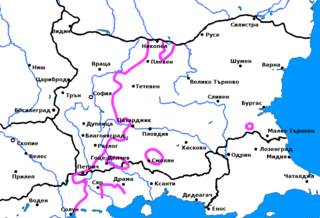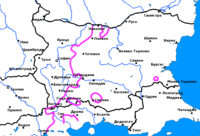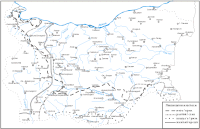
Torlakian, or Torlak, is a group of Eastern South Slavic dialects of southeastern Serbia, Kosovo, northeastern North Macedonia, and northwestern Bulgaria. Torlakian, together with Bulgarian and Macedonian, falls into the Balkan Slavic linguistic area, which is part of the broader Balkan sprachbund. According to UNESCO's list of endangered languages, Torlakian is vulnerable.

Stoyko Ivanov Stoykov was a Bulgarian linguist, Slavist.
The dialects of Macedonian comprise the Slavic dialects spoken in the Republic of North Macedonia as well as some varieties spoken in the wider geographic region of Macedonia. They are part of the dialect continuum of South Slavic languages that joins Macedonian with Bulgarian to the east and Torlakian to the north into the group of the Eastern South Slavic languages. The precise delimitation between these languages is fleeting and controversial.

The Solun-Voden dialect, Lower Vardar dialect, or Kukush-Voden dialect is a South Slavic dialect spoken in parts of the Greek periphery of Central Macedonia, and the vicinity of Gevgelija and Dojran in the Republic of North Macedonia. It has been treated as part of both Macedonian and Bulgarian dialectology.
The term Maleševo-Pirin or Maleshevo-Pirin or Pirin-Maleshevo dialect is used in South Slavic linguistics to refer to a group of related varieties that are spoken on both sides of the border of Bulgaria and the Republic of North Macedonia. Some linguists treat them as dialects of the Bulgarian language, while Victor Friedman views them as part of Macedonian. According to some authors, they are linguistically transitional between the two national languages, Bulgarian and Macedonian and form part of the larger dialect continuum between them. The dialect group is named after the mountain ranges of Pirin in Bulgaria and Maleševo in Macedonia. When referring specifically to the dialects on the Bulgarian side, the term Petrich-Blagoevgrad dialect, after the two major towns in the area, is also used.

The Ser-Drama-Lagadin-Nevrokop dialect is a dialect currently treated both in the contexts of the southeastern group of Bulgarian dialects and the southeastern subgroup of dialects of the Macedonian. Prior to the codification of standard Macedonian in 1945, the dialects of Macedonia were classified as Bulgarian. The dialect is dynamic and is well known for the shortening of the words, and also characterised by the excessive use of for the Proto-Slavic yat even in cases where standard Bulgarian has, a feature which is typical for a number of dialects spoken in southern and southwestern Bulgaria . The Ser-Drama-Lagadin-Nevrokop dialect is closely related to the neighbouring dialects. It is closer to all Eastern Bulgarian dialects than to all Western. Macedonian shares much less features with the dialect than it does with the Maleševo-Pirin dialect of Macedonian and Bulgarian. Some Bulgarian dialects are more similar to Macedonian than the Ser-Nevrokop dialect, the Samokov dialect shares more features with Macedonian than both the Ser-Nevrokop and the Pirin-Malasevo dialects do, even though it is not considered a Macedonian dialect, the most of the western Bulgarian dialects and the Smolyan dialect share more similarities with Macedonian than the Ser dialect does. The Samokov dialect, most remarkably, shares with Macedonian and the Maleševo-Pirin dialect—the "to be" verb for future tense—"ke", which in contrast is "shte" in the Ser-Nevrokop dialect and in the Bulgarian language. The Yat border passes through the Maleševo-Pirin dialect and divides it on such a way that in the northern area of the dialect the yat is pronounced "e" and in the south—"ya". In the Ser-Nevrokop dialect the yat is pronounced in most places "ya", therefore the city of Serres, after which the dialect is named, is called "Syar" by the locals, as opposed to "Ser" in Macedonian. The first person singular is as in Bulgarian, ending with "a" or "am" as opposed to the constant "am" in Macedonian and the Bulgarian Smolyan dialect. The words for man -"m'zh" and for a dream "s'n" are as in Bulgarian, unlike the Macedonian "mazh" and "son". The words for night and tear—"nosht" and "s'lza" are as the Bulgarian, unlike the Macedonian "nok" and "solza".

The Moesian dialects are a group of closely related dialects of the Bulgarian language, part of the Eastern Bulgarian dialects. The Moesian dialects are spoken in northeastern Bulgaria and in the regions of Karnobat, Aytos, Burgas and Yambol in southern Bulgaria. However, due to the mass population movements that affected eastern Bulgaria during the 19th and the beginning of the 20th century, nowadays, there are very few areas where only Moesian is spoken. In most areas, and especially in southern Bulgaria and Dobruja, Moesian speakers are mixed with speakers speaking Balkan dialects. As a result of this and also due to the influence of the literary language, most features of the Moesian dialects have given way to features typical for the Balkan dialects.

The Northwestern Bulgarian dialects are two closely related dialects of the Bulgarian language, which are located west of the yat boundary and thus are part of the Western Bulgarian dialects. The range of the dialects includes most of northwestern Bulgaria, to the west of the line between Nikopol, Pleven and Mezdra and to the north of the line between Vratsa and Belogradchik. They bear strong resemblance to their neighbouring Eastern Bulgarian dialects and with some exceptions, mainly the pronunciation of yat, have the same phonological and morphological features as the neighbouring subdialects of the Eastern Bulgarian Central Balkan dialect.

The Central Balkan dialect is a Bulgarian dialect that is part of the Balkan group of the Eastern Bulgarian dialects. Its range includes most of north-central Bulgaria, as well as the regions of Karlovo, Kazanlak and Plovdiv in southern Bulgaria, all the way down to the northernmost ridges of the Rhodopes. As a result of the mass population movements that affected eastern Bulgaria during the 19th and the beginning of the 20th century, the Central Balkan dialect is now spoken also in vast areas of northeastern Bulgaria. The most significant feature of the dialect is the pronunciation of Old Church Slavonic ѣ (yat) as or, depending on the character of the following syllable. The Central Balkan dialect lies at the foundation of formal Bulgarian. However, it is not identical to the standard language because many of its features derive from the Western Bulgarian dialects, including the Macedonian dialects, or are a compromise between Eastern and Western standard. The Central Balkan dialect includes a number of subdialects, e.g. Troyan, Lovech, Gabrovo, Karlovo, Kalofer, Tryavna, etc. which share many common features and yet have some differences.
The Strandzha dialect is a dialect of the Bulgarian language, member of the Rup or Southeastern Bulgarian dialects. The present range of the dialect includes the Bulgarian part of Strandzha. In the past, the dialect was spoken on a much larger territory and extended far down into Eastern Thrace, now in Turkey. Following the Balkan wars, the Bulgarian population there was forced to flee to Bulgaria, settling mostly in the regions of Burgas and Varna in eastern Bulgaria.

The Southwestern Bulgarian dialects are a group of Bulgarian dialects which are located west of the yat boundary and are part of the Western Bulgarian dialects. The range of the Southwestern dialects on the territory of Bulgaria includes most of west central and southwestern Bulgaria. The Southwestern dialects border on the Northwestern dialects to the north, the Transitional dialects to the northwest and the Balkan dialects and the Rup dialects to the northeast and southeast, respectively. If the Macedonian language is regarded as a third literary form of Modern Bulgarian, then the Southwestern dialects extend west and southwest to include the Slavic dialects in Vardar Macedonia and the western half of Greek Macedonia. Should the Macedonian language be counted as a separate language, then the southernmost dialect of the group, the Blagoevgrad-Petrich or Pirin dialect, along with the corresponding variety on the Macedonian side of the border, the Maleshevo dialect, constitute a transitional dialect between Bulgarian and Macedonian. A defining characteristic of the Southwestern dialects is the gradual transition from one dialect to another, as well as to dialects which belong to other dialectal groups. For example, the Dupnitsa dialect is transitional to both the Samokov dialect and the Blagoevgrad-Petrich dialect, the Botevgrad dialect is transitional to the Eastern Bulgarian Balkan dialects, and especially to the Pirdop dialect, etc. etc.
The Ihtiman dialect is a Bulgarian dialect, member of the Southwestern Bulgarian dialects, which is spoken in the regions of Ihtiman, Kostenets and Septemvri in central western Bulgaria. It is transitional between the Botevgrad and Samokov dialect.
The Elin Pelin dialect is a Bulgarian dialect, member of the Southwestern Bulgarian dialects, which is spoken in the eastern part of the Sofia valley in central western Bulgaria. Its immediate neighbours are the Vratsa dialect to the north, the Botevgrad dialect to the east, the Sofia dialect to the west and the Samokov dialect to the south.

The Transitional Bulgarian dialects are a group of Bulgarian dialects, whose speakers are located west of the yat boundary and are part of the Western Bulgarian dialects. As they have most of the typical characteristics of the North-Western Bulgarian dialects, they are sometimes classified as belonging to this subgroup under the name of Extreme North-Western dialects. On Bulgarian territory, the Transitional dialects occupy a narrow strip of land along the Bulgarian border with Serbia, including the regions of Tran, Breznik, Godech, Chiprovtsi and Belogradchik. They also cross the border to include the dialects or subdialects of the Bulgarian minority in the Western Outlands. The Transitional dialects are part of the Torlak dialectal group also spoken in southeastern Serbia and North Macedonia and are part of the gradual transition from Bulgarian to Serbian. The Bulgarian Transitional dialects and the Serbian Prizren-Timok dialects are loosely characterised by mixed, predominantly Serbian phonology and predominantly Bulgarian morphology. The features described here are characteristic only of the Transitional dialects within Bulgaria.
The Breznik dialect is a Bulgarian dialect, member of the Transitional dialects, which is spoken in the region of Graovo in central western Bulgaria. It borders on the Tran dialect to the west and north, the Kyustendil dialect to the south and the Sofia dialect to the northeast and features characteristics typical for the Southwestern Bulgarian dialects.
The Tran dialect is a Bulgarian dialect, member of the Transitional dialects, which is spoken in the regions of Tran and Godech in central western Bulgaria and in the Western Outlands. It borders on the Belogradchik dialect to the north, the Sofia dialect to the east and the Breznik dialect to the south.

The Nestram-Kostenar dialect is a Macedonian Slavic dialect spoken in parts of northwestern Greece, in the area around the village of Nestorio (Nestram) and the area known as Kostenarija, which encompasses most of the Nestorio municipality as well as in the Akrites region. There are also speakers in the adjacent Devoll District of Albania.

The Kostur dialect, is a member of the Southwestern subgroup of the Southeastern group of dialects of the Macedonian language. This dialect is mainly spoken in and around the town of Kastoria, known locally in Macedonian as Kostur, and in the surrounding Korešta region, which encompasses most of the area to the northwest of the town. The Kostur dialect is also partially spoken in Albania, most notably in Bilisht and the village of Vërnik (Vrabnik). The dialect is partially preserved among the ″people of Bulgarian origin in Mustafapaşa and Cemilköy, Turkey, descending from the village of Agios Antonios (Zhèrveni) in Kostur region ″.
Pomak language is a term used in Greece and Turkey to refer to some of the Rup dialects of the Bulgarian language spoken by the Pomaks of Western Thrace in Greece and Eastern Thrace in Turkey. These dialects are native also in Bulgaria, and are classified as part of the Smolyan subdialect. Not all Pomaks speak this dialect as their mother language.
The Eastern South Slavic dialects form the eastern subgroup of the South Slavic languages. They are spoken mostly in Bulgaria and North Macedonia, and adjacent areas in the neighbouring countries. They form the so-called Balkan Slavic linguistic area, which encompasses the southeastern part of the dialect continuum of South Slavic.
![Map of the big yus (*o) isoglosses in Eastern South Slavic and eastern Torlakian according to the Bulgarian Academy of Sciences' atlas from 2001. Pronunciation of man and tooth, derived from Proto-Slavic words *moz' and *zob' on the map:
1. [muS]
, [zup]
(see z'b)
2. [maS]
, [zap]
(see zab)
3. [muS]
, [zup]
4. [maS]
, [zap]
5. [moS]
, [zop]
6. [maeS]
, [zaep]
7. [munS]
, [zump]
8. [manS]
, [zamp]
9. [manS]
, [zamp] Bulgarian dialect map-yus.png](http://upload.wikimedia.org/wikipedia/commons/thumb/d/d5/Bulgarian_dialect_map-yus.png/200px-Bulgarian_dialect_map-yus.png)
















